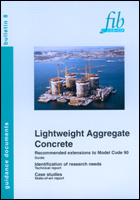Lightweight aggregate concrete
Part 1 – Recommended extensions to Model Code 90.
Part 2 – Identification of research needs.
Part 3 – Application of lightweight aggregate concrete.
Guide (part 1), technical report (part 2) and state-of-the-art (118 pages, ISBN 978-2-88394-048-2, January 2000)
fib Bulletin No. 08
Title: Lightweight aggregate concrete
Category: Guide (part 1), technical report (part 2) and state-of-the-art report (part 3)
Year: 2000
Pages: 118
Format approx. DIN A4 (210x297 mm), 7 tables,
80 mostly coloured illustrations
ISBN: 978-2-88394-048-2
Abstract: Part 1 – Recommended extensions to Model Code 90
Starting in 1995 as a Joint CEB/FIP Working Group on Lightweight Aggregate Concrete (LWAC), the group was after the merger of CEB and FIP attached to the new fib Commission 8 Concrete. As a background for an extension of the CEB/FIP Model Code 1990 (MC 90) it delivered firstly Bulletin 4. Similarly to what has been done before in the field of High Strength / High Performance Concrete the present guide identifies the lacunae in the existing MC90 and proposes supplementary or alternative solutions to be applied for lightweight aggregate concretes. In order to facilitate its use the report is edited in two columns following the numbering of the CEB-FIP Model Code 1990.
The group has given preference to topics of practical importance for LWAC structures, and for which reliable information is available. Justifications of the proposed extensions are to be found in the references to each section.
Part 2 – Identification of research needs
The technical report identifies the research needs resulting from those clauses of MC 90 which need amendment, and for which more basic research should provide a better understanding of mechanical, physical and chemical processes.
Part 3 – Application of lightweight aggregate concrete
The state-of-art report documents 33 application examples of projects world-wide. Twenty-eight two-page and five one-page presentations aim to explain the motivation for adopting this technology and report on the design considerations and codes applied, the practical experience during design and construction, the results obtained and the infield performance; for each example references list the literature where more detailed information can be found.



